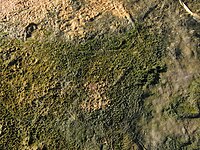
Photo from wikipedia
Abstract Dinoflagellate cysts (dinocysts) are commonly used to reconstruct past environmental conditions at the sea surface, such as primary production, temperature and salinity. Abundances of selected dinocyst taxa are used… Click to show full abstract
Abstract Dinoflagellate cysts (dinocysts) are commonly used to reconstruct past environmental conditions at the sea surface, such as primary production, temperature and salinity. Abundances of selected dinocyst taxa are used in qualitative indices, whereas the modern analogue technique (MAT) is used for quantitative reconstructions. Qualitative indices use process-based knowledge of present-day relations between the environmental variables and the distribution of dinocysts, whereas the MAT is based on the assumption that past assemblages have modern counterparts that correspond to similar sea-surface conditions. Here we explore the potential of both approaches to reconstruct sea surface temperature (SST), production (SSP), salinity (SSS) and seasonality during the last 22 thousand years along the West Iberian Margin (WIM), at Integrated Ocean Drilling Program (IODP) Site U1385. We compare results to published paleoclimatic reconstructions. Our SST and SSS reconstructions provide the first continuous dinocyst MAT-based SST and SSS records for this area and time interval. Qualitative and quantitative dinocyst-based SST estimates from the WIM are similar and resemble previous SST estimates from dinocysts, alkenones and foraminifers from nearby sites. The surface temperature trends and millennial-scale variations largely match those from the Greenland ice core records. Quantitative MAT-based SST estimates show increased seasonality in the glacial stage resulting from strong winter cooling. Dinocyst MAT-based salinity decreases concomitantly with cooling during the Younger Dryas and Heinrich Stadial 1 (HS1), likely related to the melting of icebergs that reached the region during HS1. Our qualitative and quantitative SSP estimates show higher values in the glacial stage compared to the Holocene, which is consistent with published records and supports the usefulness of both approaches. Small differences between SST tracer records may be explained by the limited number of modern analogues from warm ocean regions in the dinocyst reference dataset for MAT, the small number of dinocysts used in the qualitative estimates, the possible effect of a parameter other than temperature that might amplify noise, and/or seasonal biases of the tracer species. In any case, the advantage of the qualitative approach is to allow reconstructions in non-analogue situations. Regression of the qualitative index versus present-day SST also allows for a quantitative reconstruction, although over a limited range of SSTs (especially towards the lower end) and with quite some uncertainty, but produces reasonable values beyond the upper limit of the MAT. The MAT reconstructs more reliable SSTs, with a much smaller error of prediction, but only up to present-day WIM values, because it is based on the assumption that past assemblages have modern counterparts that correspond to similar sea-surface conditions, which is not always valid. The advantages of the MAT approach include its quantitative nature and insights into seasonality. Hence both approaches are complementary. At Site U1385, MAT can be used for reconstructions in the colder periods (YD, HS1 and glacial stage), with a small error of prediction and the quantified index can be used to estimate SST beyond the limit of the MAT (Holocene and B-A).
Journal Title: Marine Micropaleontology
Year Published: 2017
Link to full text (if available)
Share on Social Media: Sign Up to like & get
recommendations!